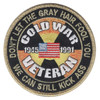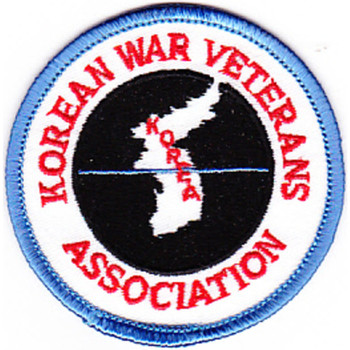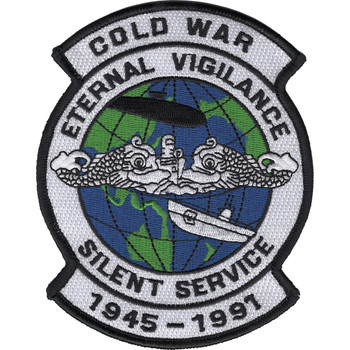Formations & Origins
The Cold War Veteran Patch symbolizes the dedication and service of men and women who served in the U.S. military during the Cold War, a period that spanned from the end of World War II in 1945 to the dissolution of the Soviet Union in 1991. This patch was created to honor the veterans who contributed to the long, tense standoff between the United States and the Soviet Union, a conflict that was marked by political tension, military competition, and ideological battles, but was not characterized by direct large-scale military combat.
The Cold War was primarily a war of attrition fought through proxy wars, espionage, and nuclear deterrence, with the military standing as the backbone of the U.S. strategy. The Cold War Veteran Patch acknowledges the sacrifices of these service members who, though often operating in indirect combat, played a crucial role in maintaining global stability, protecting democracy, and ensuring that the United States was prepared for any potential conflict with the Soviet Union. It is a reminder of the soldiers who stood on the front lines of this ideological war, whether through serving in NATO, engaging in intelligence gathering, supporting covert operations, or preparing for the worst-case scenario: nuclear war.
Notable Commanders
While the Cold War period featured a wide range of military leaders, many of whom became icons in U.S. military history, a few stand out due to their leadership in shaping Cold War military strategy. General Curtis LeMay, for example, was a key figure in the U.S. Air Force during the Cold War. He played a pivotal role in the development of the U.S. nuclear strategy and the creation of the Strategic Air Command (SAC), which was charged with maintaining the U.S. nuclear arsenal and ensuring its readiness in the event of Soviet aggression.
Another prominent leader was Admiral Hyman G. Rickover, known as the "Father of the Nuclear Navy." His work in the development of nuclear-powered submarines and naval reactors fundamentally changed naval warfare during the Cold War, ensuring that the U.S. Navy maintained a strategic advantage. His leadership and influence were crucial in strengthening the U.S. military's ability to project power beneath the waves during this era.
Major Campaigns/Operations
The Cold War Veteran Patch is a symbol of service during a period marked by numerous significant military operations and geopolitical tensions, even though the U.S. never fought the Soviet Union directly in large-scale combat. The key confrontations during this period were proxy wars in various regions of the world, such as the Korean War (1950-1953) and the Vietnam War (1955-1975). Both conflicts were fought as part of the larger Cold War struggle, with the U.S. supporting South Korea and South Vietnam, respectively, in an effort to prevent the spread of communism.
In addition to these conflicts, the Cold War period saw several critical military operations that helped define the U.S. military's strategy, including Operation Rollback (which aimed to contain communism in Europe and Asia) and Operation Eagle Claw, the failed rescue mission to free American hostages in Iran in 1980. In the skies, The Berlin Airlift (1948-1949) stands as a shining example of Cold War military diplomacy, where the U.S. and its allies flew supplies into West Berlin after the Soviet Union blocked all land access to the city.
The most visible part of the Cold War was the nuclear arms race. Both the U.S. and the Soviet Union spent the Cold War building and stockpiling nuclear weapons in a tense rivalry that never turned into direct confrontation but nevertheless had a massive impact on the military, global politics, and security. Operation MINUTEMAN and the creation of the Intercontinental Ballistic Missile (ICBM) silos in the U.S. were part of this nuclear standoff, and the strategic placement of military forces and weaponry to maintain deterrence became a critical element of U.S. military operations during the era.
Specialized Role/Equipment
The men and women who served during the Cold War were often tasked with maintaining peace through readiness for war. The Cold War Veteran Patch speaks to this specialized role of constant vigilance and preparedness. The military built and maintained an arsenal of nuclear weapons, developed sophisticated surveillance and reconnaissance systems, and implemented extensive training programs to prepare for the worst-case scenario.
Cold War military equipment was advanced, with the development of high-tech weaponry such as ballistic missiles, nuclear-powered submarines, and spy satellites. The U.S. also deployed B-52 Stratofortress bombers and Minuteman missiles, with the constant threat of a Soviet nuclear attack making strategic weapons like these a major component of U.S. defense strategy.
In addition to conventional weapons systems, specialized Cold War-era technology, such as radar detection systems, stealth aircraft (like the SR-71 Blackbird), and cryptography technology, helped to provide the U.S. with an edge in the war of espionage and covert operations. Intelligence and surveillance during the Cold War era were vital, with both sides constantly trying to outmaneuver each other using state-of-the-art equipment. The Cold War Veteran Patch reflects not just the soldiers who wore it but the high-tech environment they operated in, where military personnel were integral to the success of sophisticated and often classified missions.
Acts of Heroism
The Cold War was often a period of quiet heroism, with many military personnel performing vital work that kept the world on the edge of peace while facing constant threats of escalation. One key example of heroism comes from the Cuban Missile Crisis (1962). In this intense 13-day standoff, U.S. military personnel played a crucial role in defusing the situation. On the U.S. Navy front, crews of submarines like the USS Beale and USS Wasp were tasked with maintaining pressure on Soviet forces while ensuring the readiness of U.S. forces to respond. Submarine crews, in particular, displayed heroism during the crisis, maintaining vigilance as part of the U.S. nuclear deterrent.
Another example of Cold War-era heroism occurred during the Berlin Airlift (1948-1949), where U.S. Air Force and other Allied aircrews risked their lives to keep West Berlin supplied while the Soviet Union blockaded the city. Hundreds of thousands of flights were made, with military pilots and ground crews showing courage under pressure as they delivered food, medicine, and fuel to citizens trapped in a divided Berlin.
Similarly, during the Vietnam War, many service members displayed incredible bravery, such as Special Forces soldiers and Naval advisers who fought and died in a protracted conflict that exemplified the ideological struggle of the Cold War. Although it was often seen as a proxy war, the acts of heroism by U.S. soldiers, sailors, and airmen on the ground, in the air, and at sea were tangible reminders of the personal sacrifices made during this time.
Legacy & Notable Achievements
The legacy of the Cold War Veteran Patch is a lasting tribute to the courage, resilience, and vigilance of the individuals who served during this era. The Cold War may not have produced a conventional war, but it led to significant advancements in technology, strategy, and international relations. The nuclear arms race spurred the development of nuclear-powered submarines, advanced missile systems, and more secure forms of communication and intelligence gathering.
The Cold War Veteran Patch also symbolizes the role that the U.S. military played in protecting the global order and preventing the spread of communism. While many of the battles fought during the Cold War were not on the front pages of newspapers, the victories in intelligence gathering, diplomacy, and the establishment of global alliances were just as significant as any battlefield victory.
In addition, the patch honors the veterans who served in various theaters around the world in conflicts like Korea, Vietnam, and the many covert operations that took place throughout Africa, Latin America, and Asia. The work of these men and women, often out of the public eye, laid the groundwork for the end of the Cold War and the eventual collapse of the Soviet Union in 1991.
The Cold War Veteran Patch is a recognition of all those who stood ready to defend the U.S. during one of the most volatile periods in modern history. Their actions, whether in covert operations, standing guard against nuclear attack, or fighting in proxy wars, helped shape the world we live in today, and their legacy is one of sacrifice, patriotism, and commitment to peace through strength.


















